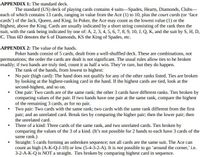
USE C++ OR JAVA --- POST SOURCE CODE
WILL UPVOTE FOR CORRECT ANSWER ONLY
---------------------------------------------------------------------------------------------------
Create a simple program that plays poker 1000 times with the following rules:
Each time the program will:
- Shuffle the 52-card deck and deal yourself 5 cards.
- Using the remaining 47 cards, deal other 5 players their 5 cards.
- Determine if your hand would win or lose compared to the others. (Poker hands ranking listed below for reference)
- Your program will produce 2 output files (1000 entries):
- A session log output as a CSV (comma-separated value) file, with each hand (you and 5 other hands) on a separate line. For each hand: Output the cards in the hand; what the hand was evaluated as; and its winning percentage.
- A summary showing the percentage of hands falling into each rank, and the overall win percentage for each rank, as a ‘normal’ text file.
---------------------------------------------------------------------------------------------------
The system random-number generator (random() and related functions) for the most common development environments will be more than adequate for this project.
Picture reference for card rankings:


The question involves making an an entire game which is beyond the scope of answer, we thus answer with a poker game code instead and the game method can be called 1000 times and be saved in a csv.
Step by stepSolved in 5 steps

 Computer Networking: A Top-Down Approach (7th Edi...Computer EngineeringISBN:9780133594140Author:James Kurose, Keith RossPublisher:PEARSON
Computer Networking: A Top-Down Approach (7th Edi...Computer EngineeringISBN:9780133594140Author:James Kurose, Keith RossPublisher:PEARSON Computer Organization and Design MIPS Edition, Fi...Computer EngineeringISBN:9780124077263Author:David A. Patterson, John L. HennessyPublisher:Elsevier Science
Computer Organization and Design MIPS Edition, Fi...Computer EngineeringISBN:9780124077263Author:David A. Patterson, John L. HennessyPublisher:Elsevier Science Network+ Guide to Networks (MindTap Course List)Computer EngineeringISBN:9781337569330Author:Jill West, Tamara Dean, Jean AndrewsPublisher:Cengage Learning
Network+ Guide to Networks (MindTap Course List)Computer EngineeringISBN:9781337569330Author:Jill West, Tamara Dean, Jean AndrewsPublisher:Cengage Learning Concepts of Database ManagementComputer EngineeringISBN:9781337093422Author:Joy L. Starks, Philip J. Pratt, Mary Z. LastPublisher:Cengage Learning
Concepts of Database ManagementComputer EngineeringISBN:9781337093422Author:Joy L. Starks, Philip J. Pratt, Mary Z. LastPublisher:Cengage Learning Prelude to ProgrammingComputer EngineeringISBN:9780133750423Author:VENIT, StewartPublisher:Pearson Education
Prelude to ProgrammingComputer EngineeringISBN:9780133750423Author:VENIT, StewartPublisher:Pearson Education Sc Business Data Communications and Networking, T...Computer EngineeringISBN:9781119368830Author:FITZGERALDPublisher:WILEY
Sc Business Data Communications and Networking, T...Computer EngineeringISBN:9781119368830Author:FITZGERALDPublisher:WILEY





